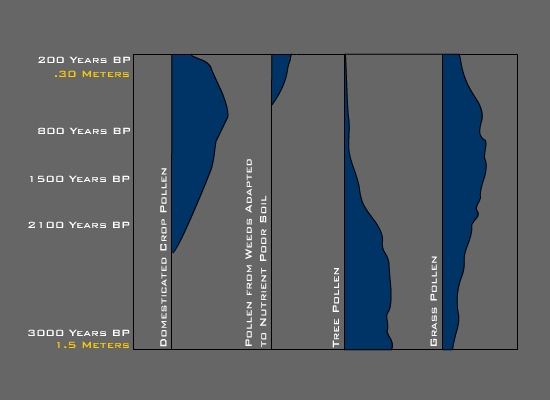
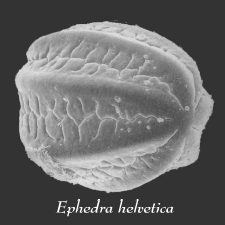
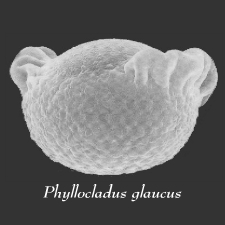
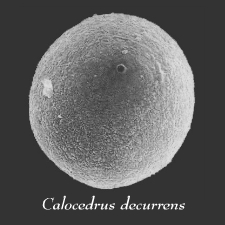
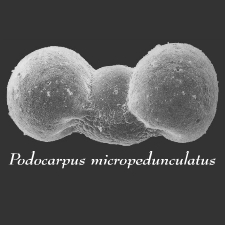
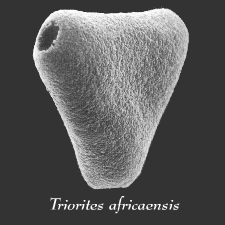
Palynology, the study of pollen grains, is one of the most effective tools we have to reconstruct past environment. Because exines, the hard outer shells of pollen grains, of different species are unique (illustrated at left) and can survive in favorable conditions for thousands of years, palynolgists can identify many plants that were present in the past. Working with this information, archaeologists can then discover more about how humans in the past interacted with their environment.
On a large scale, palynology can identify broad environmental trends. Pollen grains are the tiny male reproductive bodies of flowering plants. Different types flowering plants have evolved different methods of ensuring that these male reproductive bodies reach their appropriate female counterpart. One of these methods is windblown distribution. Because the wind randomly distributes the pollen grains, the plant must produce a huge amount of extra pollen to ensure that at least some of it reaches its intended destination. This extra pollen, called pollen rain, is eventually deposited on the ground where, if conditions are favorable, it may persist for thousands of years. Lake sediments and peat bogs are particularly valuable for preserving pollen grains not only because they are chemically suitable but also because they accumulate over time. Thus as the pollen rain falls in these places, it is incorporated into the ever growing sedimentary or plant deposits. When pollen falls on regular soil, it tends to migrate downwards with the water percolating through the soil. By mixing modern and ancient pollen together, this creates a more difficult, but not impossible, situation for the palynologist to evaluate.
By taking samples from a continuous sequence of soil depths and then extracting, identifying, and counting the pollen in each level, palynologists create a pollen profile of an area over a specific time. The pollen profile can then be plotted as a graph. For example, in the pollen profile illustrated below, continuous samples of a meter of soil were taken from between two meters and three meters depth. Dates for the different levels were established by other methods using associated data.

The pollen grains that were extracted and identified from each sample were then counted and plotted by type (in blue) on the graph. Changes to the environment caused by human action now become readily visible. At about 3000 BP, the original forest cover is represented by high levels of pine, oak, and elm pollen and low or nonexistent amounts of grass and shrub pollen. After about 2450 BP, the impact of non-intensive farming is represented by much higher levels of grasses and shrubs which prosper in the newly cleared areas. Subsequent abandonment is indicated by by increased shrub and tree pollens representing forest regeneration. With forest cover once again reestablished at 2000 BP, the grasses and shrub pollens disappear and tree pollen increases. A second period of clearance is witnessed by the return of the grass and shrub pollens and a decrease in pine and elm pollen.
Such large scale reconstructions are not the only application of palynology. On a smaller scale, palynology can be used to reconstruct the individual utilization of plant resources. Pollen's tendency to cling to other plant materials after the plant has been harvested enables the identification of ancient human behaviors. For example, fodder storage for domesticated animals can be identified from large concentrations of grass and forb pollen found inside human constructions. Human diet can also be reconstructed. In the American Southwest, palynologists have successfully used human coprolites, or preserved feces, containing pollen to reconstruct a prehistoric individual's diet.
In rather more appealing study of human diet, palynologists in Scotland have used pollen grains found in an apparently insignificant piece of broken pottery to reconstruct the long lost recipe for an ancient Celtic heather ale. Reputedly, this recipe was lost before the Middle Ages, when the last two brewers chose death rather than reveal the secret recipe to inquisitive raiders. The legends say that the elder brewer told the raiders that they would have to kill his son before he would give them the recipe. When they did so, he mocked them, saying "You should have killed me first because I shall never tell you the secret." But in 1985, with pollen grains from the apparently insignificant piece of broken pottery, palynologist Dr. B. Moffat was able to identify the components of the Celtic heather ale by identifying pollen from heather, royal fern, meadowsweet, and other grains and herbs. Although he was not sure of the correct proportion of ingredients, Dr. Moffat brewed a few bottles of the ale, which he described as a "very drinkable alcohol, comparing quite favorably with beers available in various Edinburgh hostelries… a bit savage perhaps for modern palates." A distillery in Scotland has been experimenting with the recipe and Celtic heather ale may eventually become commercially available - thanks to palynology.

1. The following is a simplified representation of a pollen profile based on continuous soil samples spanning approximately 2200-4000 BP years at a site in southwestern New Mexico. Describe (A) the changes in the plant environment and (B) the possible corresponding human actions occurring in each time interval listed below:
A. 4000-3600 years BP
B. 3600-3400 years BP
C. 3400-2900 years BP
D. 2900-2200 years BP2. The following is a simplified representation of a pollen profile based on continuous soil samples spanning approximately 3000-200 years BP at a site on Easter Island. Describe (A) the changes in the plant environment and (B) the possible corresponding human actions occurring in each time interval listed below:
A. 3000 -2100 years BP
B. 2100-1500 years BP
C. 1500-800 years BP
D. 800-200 years BP3. Based on the high levels of pollen found among building foundations at this 18th Century site in rural New England, match each building to one of the uses listed below:
Flour mill
General store
Barn
Storage shed for farm implements
Brewery
Weaver's shop
Private house
Private house
Private house
Church
Carpenter's shop
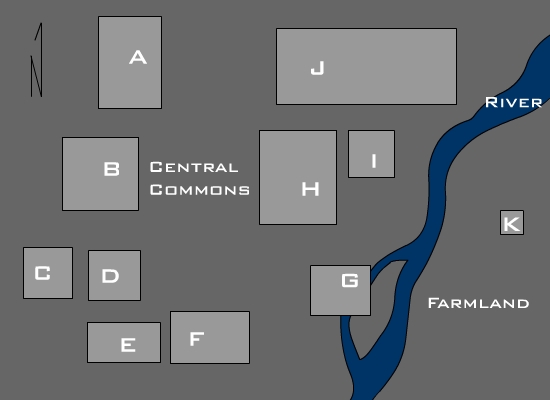
Building A: Local and imported produce (i.e. food) pollens
Building B: No great concentration of any type of pollen
Building C: Cotton pollens
Building D: Local and imported produce (i.e. food) pollens
Building E: Local and imported produce (i.e. food) pollens
Building F: Local and imported produce (i.e. food) pollens
Building G: Wheat and corn pollens
Building H: Wheat, barley, and hops pollens
Building I: Tree pollens
Building J: Grass and clover pollens
Building K: wildflower pollens
SEM images of fossilized pollen exines modified from Kurman, M.H. and J.A. Doyle (eds.) 1994. Ultrastructure of Fossil Spores and Pollen. Royal Botanical Gardens, Kew, England. Pollen graph in text modified from Renfrew, C. and P. Bahn 1991. Archaeology: Theories, Methods, and Practice. Thames and Hudson, New York.

